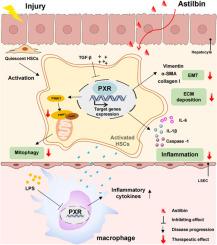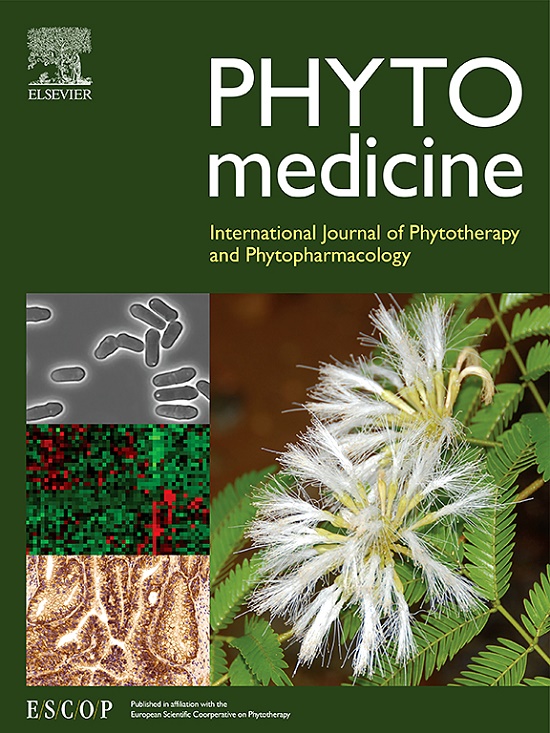Astilbin通过PXR-PINK1/Parkin通路缓解肝纤维化:调节肝星状细胞-巨噬细胞串联的新策略
IF 6.7
1区 医学
Q1 CHEMISTRY, MEDICINAL
引用次数: 0
摘要
背景芪黄素(ATB)是一种天然二氢黄酮醇化合物,存在于许多植物、加工食品和功能食品中。ATB具有多种药理作用,如抗氧化、降血脂和保肝。方法腹腔注射硫代乙酰胺(TAA)建立肝纤维化小鼠,分别灌胃ATB或姜黄素治疗。用TGF-β或LPS诱导的THP-1的条件培养基(CM)刺激肝星状细胞(HSCs),然后用ATB、PXR激动剂或拮抗剂培养HSCs。结果 在 TAA 诱导的小鼠中,ATB 可改善组织病理学变化、血清转氨酶升高;减轻细胞外基质(ECM)沉积、上皮-间质转化(EMT)、炎症浸润、PTEN 诱导激酶 1(PINK1)/Parkin 介导的有丝分裂和激活孕烷 X 受体(PXR)表达。在体外,ATB 能明显减少 ECM、炎症细胞因子释放、有丝分裂、EMT 和活化的 PXR 表达。ATB 能增加 PXR 并减少 PINK1/Parkin,从而起到 PXR 激动剂的作用。LX-2 中 PXR 的缺乏会降低 ATB 对 ECM、炎症、EMT 和有丝分裂的调节作用。LPS诱导的THP-1的CM能激活LX-2并导致PXR下降,而ATB能调节造血干细胞和巨噬细胞之间的串联。结论ATB通过PXR介导的PINK1/Parkin信号转导抑制造血干细胞活化、炎症和EMT,从而改善肝纤维化。ATB通过PXR介导的PINK1/Parkin信号抑制造血干细胞的活化、炎症和EMT,从而改善肝纤维化,特别是ATB靶向作用于肝星状细胞和巨噬细胞之间的肝脏微环境,这可能是治疗肝纤维化的一种有前景的策略。本文章由计算机程序翻译,如有差异,请以英文原文为准。

Astilbin alleviates hepatic fibrosis through PXR-PINK1/Parkin pathway: A new strategy by regulating hepatic stellate cells-macrophage crosstalk
Background
Astilbin (ATB), a natural dihydroflavonol compound, exists in many plants, processed and functional foods. ATB has multiple pharmacological effects, such as antioxidant, lipid-lowering, and hepatoprotective. However, its anti-hepatic fibrosis and mechanisms remain unclearly elucidated.
Purpose
This study explored the effect of ATB against the hepatic fibrosis and its regulation of hepatic microenvironment by regulating hepatic stellate cells-macrophage crosstalk.
Method
Thioacetamide (TAA) was intraperitoneal injected to establish hepatic fibrosis mice, and treated with ATB or curcumin by gavage, respectively. Hepatic stellate cells (HSCs) were stimulated with TGF-β or conditioned medium (CM) from LPS-induced THP-1, then cultured with ATB, PXR agonist or antagonist.
Results
In TAA-induced mice, ATB improved histopathological changes, serum transaminases increase; alleviated extracellular matrix (ECM) deposition, epithelial-mesenchymal transformation (EMT), inflammatory infiltration, PTEN induced kinase 1 (PINK1)/Parkin-mediated mitophagy and activated pregnane X receptor (PXR) expression. In vitro, ATB significantly reduced ECM, inflammatory cytokines release, mitophagy, EMT, and activated PXR expression. ATB could increase PXR and decrease PINK1/Parkin, functioning as a PXR agonist. PXR deficiency in LX-2 could degrade the regulation of ATB on ECM, inflammation, EMT, and mitophagy. CM from LPS-induced THP-1 activated LX-2 and resulted in PXR decreasing, while ATB could regulate the crosstalk between HSCs and macrophages. Deficiency of PXR, whether in LX-2 or in macrophages, all weakened the inhibitory effect of ATB on α-SMA, EMT, inflammatory cytokines, and PINK1/Parkin signaling.
Conclusion
ATB ameliorated hepatic fibrosis by inhibiting HSCs activation, inflammation and EMT through PXR-mediated PINK1/Parkin signaling. Especially, ATB targeted the hepatic microenvironment between hepatic stellate cells and macrophages, which might be a promising strategy for the treatment of hepatic fibrosis.
求助全文
通过发布文献求助,成功后即可免费获取论文全文。
去求助
来源期刊

Phytomedicine
医学-药学
CiteScore
10.30
自引率
5.10%
发文量
670
审稿时长
91 days
期刊介绍:
Phytomedicine is a therapy-oriented journal that publishes innovative studies on the efficacy, safety, quality, and mechanisms of action of specified plant extracts, phytopharmaceuticals, and their isolated constituents. This includes clinical, pharmacological, pharmacokinetic, and toxicological studies of herbal medicinal products, preparations, and purified compounds with defined and consistent quality, ensuring reproducible pharmacological activity. Founded in 1994, Phytomedicine aims to focus and stimulate research in this field and establish internationally accepted scientific standards for pharmacological studies, proof of clinical efficacy, and safety of phytomedicines.
 求助内容:
求助内容: 应助结果提醒方式:
应助结果提醒方式:


